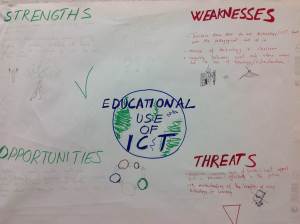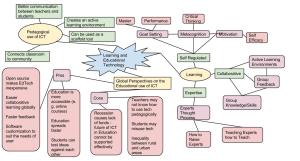Today we were put into groups where we each presented articles we had read in our spare time. The articles all discussed the global perspectives on the educational use of ICT. After presenting the articles within our groups, each group collaboratively made a SWOT analysis poster (Strengths, Weaknesses, Opportunities and Threats) – which we then presented to the whole class.
My groups poster:
We started by defining a few strengths that ICT brings to education:
- open source software makes the cost of using EdTech very cheap – as open source software is quite literally free. Meaning that institutions only need to pay for the technological equipment in order to take advantage of the software.
- with the use of the internet it’s easier to perform collaborative learning globally – as students anywhere in the world are able to communicate with each other instantaneously through such applications as Google Drive.
- feedback in on work/ideas is facilitated with EdTech – again thanks to the internet easing communication between students and teachers via the use of e-mail or dedicated school/university websites or web mail.
- software can be created to suit the needs of the learner – for example, a dyslexic university student could be given a program facilitating their essay writing. Such things would allow students with learning problems to progress without the need for assistance from others – which they may tend not to accept as they find asking for help embarrassing.
Afterwards we considered what opportunities ICT offers education:
- education is more accessible world wide through the net – as online courses make education available to students who may live in remote locations.
- if open source software increases then educational technology will spread faster as the software is free – meaning that, once again, beneficial educational tools reach more people which then promotes and allows effective education to be taught.
- as educational technology spreads the internet will allow students to test their ideas against other cultures – which will help to promote growth and understanding around the world.
After tackling the positive aspects of ICT in education we took time to look at the negatives that come with it. Starting with the weaknesses:
- teachers may know how to use technology but do not understand how to use technology – but they don’t understand how to use it pedagogically. This can be seen as a weakness as teachers may use technology inappropriately, which in turn may hinder or even hurt the learning of the students.
- not only teachers but students themselves might use technology inappropriately. As, for example, students might use the technology assigned to them to play games or check facebook – instead of using it to complete the task at hand. Which, again, would hamper or hurt their learning.
- there might also be problems when it comes to providing the same level of educational technology between urban and rural areas due to lack of technology/infrastructure in the more rural locations.
Finally we took a look at the threats technology poses when integrating it into education:
- the current economical climate around the world means that – in the future – educational ICT might not be properly supported if another recession occurs. For example, technology previously purchased could break and schools would not be able to afford the maintenance costs in order to repair it.
- the benefits of ICT might be misunderstood when it comes to learning. Meaning that we might end up discovering that we have misused it in some way.
- we could also end up impairing our ability to learn effectively without technology in the future – if we become too over reliant on its use.
Personally, I believe that the potential benefits technology brings to education are far too great to be ignored. Speaking as someone who was bed ridden for a lengthy period of time at one point in my life – the correct use of educational ICT allowed me to finish my studies and graduate from my previous institution on time due to the online facilities that my university had. Without them, it may have taken me up to an extra year or two to reach where I am today.
Although I can admit that weaknesses are indeed present when it comes to the educational use of ICT – I feel that most of them are fairly easy to remedy. For instance: teachers themselves can be taught the best way to use ICT pedagogically, students can be monitored when using technology to make sure they do not misuse it and if a funding plan is properly produced by the government – technology could be distributed adequately between both rural and urban areas. However, I still harbour some concerns that the overuse of technology could result in some unavoidable negative effects; I fear that people may become too reliant on technology and there is also the very real threat that, by introducing technology to schools, students may come to physically harm themselves from over using technology if they use it both at home and in school (indeed, eye strain is something that I myself suffered from during the time I was bed ridden).
Regardless, as long as EdTech is used appropriately and in moderation – I think it is very beneficial to the future of education.
Updated Mindmap:


Hi Nick,
you have summarized quite nicely all the main contents of the INTRO-course into your blog. Especially the possibilities of technology in education is widely discussed. You have utilized core course materials to support your reflection. The structure of the blog is very clear and also the technical implementation is successful.
In one of your posts you point out that lack of contribution is one main challenge in collaborative learning. This is absolutely true, both research and practical experiences have evidences this. However, there are several possibilities to try to avoid this. For example scripting has turned out to be a powerful tool to commit every group member into collaboration. We will discuss about scripting in more details next spring in TEL-course.
To sum up, you have been doing good job throughout the course! I hope you continue that way also in upcoming courses 🙂 .